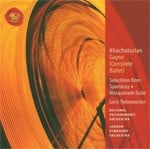Gayaneh (original 1942 version)
(Gajaneh (Version I in 4 Akten, 1942)) (1941-42)Scenario by Konstantin Derzhavin
3(III=picc).2.corA.3(III=bcl).asax.2-4.crt.3.atpt.3.1-timp.perc:tgl/wdbl/tamb/SD/BD/cyms/tam-t/h.bells/tubaphon/glsp/xyl/doli*/daira**-tar***.kamancheh****.tulumbasso-harp-cel-pft-str
*doli = double-headed cylindrical drum of Georgian origin
**daira = single-headed round drum of Caucasian origin
***tar = long-necked, waisted lute family instrument of Iranian origin
****kamancheh = bowed string instrument of Iranian origin
(or other similar instruments)
Abbreviations (PDF)
VAAP
<DIR=LTR align="left">Having himself been born and brought up in Georgia, Khachaturian’s formative musical influence had not been so much Armenian as a trans-Caucasian mix of Georgian, Armenian and Azerbaijani folk and urban songs and dances. Intending to write an ‘Armenian ballet’, Khachaturian therefore spent much of 1939 in Armenia, the land of his ancestors. The ballet which eventually emerged, after a false start as a work called Happiness, was Gayaneh, including the celebrated Sabre Dance. This was, in fact, a late addition to the ballet; Khachaturian initially regarded this piece initially as something of a joke, and then an embarrassment which overshadowed his other music, including some very fine numbers from that same ballet. One of these is the haunting Adagio, which since being featured in Stanley Kubrick’s film 2001: A Space Odyssey has been alluded to or plagiarized by several Hollywood film composers; yet the original dance – rather like Barber’s Adagio – still packs a powerful emotional punch.
The ballet exists in at least two versions – the 1942 version which contains all the favourite numbers, and the extensively restructured 1957 version – and three official orchestral suites were arranged by the composer.
Here is a list of both the most popular and the most striking numbers from the ballet (asterisked numbers are only partially represented or not included in any of the published suites):
Mountaneers – a wonderfully over-the-top number, with aggressively stomping brass and percussion perfectly complemented by wailing strings.
Invention or Gayaneh’s Adagio – a very effective and (relatively) understated number which expresses the title character’s despair over being at the mercy of her brutish husband, Giko.
Ayesha’s Awakening and Dance – its tremendously atmospheric opening suggests sinister night sounds above which a flute pipes. The following dance is perhaps more conventional, but memorable in a manner reminiscent of Gershwin’s Porgy and Bess.
Armen’s Variation – a ferocious, bold and masculine number which makes a powerful impact and could make a good encore.
Lezghinka – colourful and fiery with exciting cross-rhythms, this combines authentic drumming with exuberant Borodin-style woodwind and brass: a sure-fire encore.
Fire – renamed Storm in 1957, this is a powerful musical portrayal of the cotton farm in flames due to the evil machinations of Giko.
Note by Daniel Jaffé

National Philharmonic Orchestra/Loris Tjeknavorian
RCA 82876-65836-2 (2 disc set)
Buy this CD from Amazon
